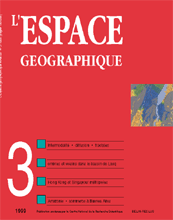

Pierre ARNOLD, Isabelle THOMAS. An attempt at modelling the optimal location of transshipment points in a multimodal system. (2 tabl., 5 fig.)
Multimodality can be a competitive alternative for the transport of people or goods. An important factor in this competitiveness is the location of transshipment points, i.e. the junctions between different transport modes or networks. This paper discusses this issue from the angle of location theory. The location of transshipment points is defined as a distinct issue involving the optimal location of facilities for transfers from one network to another with the objective of reducing total transport costs. These costs are defined as the sum of the transshipment costs and the cost(s) associated with the transport mode(s) operating on each network; these latter costs are a function of the distance covered on each network and of the volumes transported. An analytical solution is proposed and discussed. An example of application to freight transport in Belgium illustrates its relevance.
keywords: MULTIMODALITY, OPTIMAL LOCATION, NETWORKS, TRANSSHIPMENT
Accessibility and spatial diffusion. (1 tabl., 3 fig.)
The goal of this paper is to define accessibility as a more appropriate measure than distance for modelling mechanisms of spatial distribution. Accessibility is then used as an important element in a multi-agents model which aims to imitate some processes of spatial diffusion.
keywords: ACCESSIBILITY, DISTANCE, MULTI-AGENTS MODEL, SPATIAL DIFFUSION
Emmanuel HAUCHARD, Daniel DELAHAYE, Pierre FRANKHAUSER. Morphological talweg analysis and scaling behaviour: applying non-integer dimensions to physical geography. (5 tabl., 5 fig.)
The organisation of the talweg network is fundamental to the erosion system on the silty loamy plateaux of north-western France. The morphology of the Pays de Caux is a good example of successive runoff concentration caused by the nesting of small dry valleys. These are inherited from a periglacial climate and their general direction is governed by tectonics. However the detailed pattern of these forms remains complex and without obvious explanation. Non-integer dimensions may offer a ceratin logic to this relatively chaotic pattern. This paper has therefore sought to demonstrate the fractal side of these talwegs by incorporating lithology as an explanatory variable.
keywords: FRACTAL DIMENSION, LITHOLOGY, PAYS DE CAUX, PERIGLACIAL, SCALING BEHAVIOUR, TALWEG, TECTONICS, TERTIARY DEPOSITS
Yves POINSOT. The role of the neighbouring environment in geographical organisation: the industrial area of Lacq. (4 fig.)
The distribution of geographical objects in the industrial area of Lacq is partly determined by the need to ensure or to avoid certain relationships of proximity. Some of these lateral relationships are accidental, i.e. "irrelevant", and are known as interferences. Their existence can generate original spatial layouts. Shadow perimeters, around hazardous areas or sources of industrial pollution, may extend well beyond the limits of the neighbouring areas. Geographical areas should therefore be defined not only according to their location, but also to their nature and the interferences resulting from their neighbouring environment.
keywords: HAZARDS, INDUSTRY, INTERFERENCE, LACQ, NEIGHBOURING ENVIRONMENT
Nathalie FAU. Hong Kong and Singapore: cross-border metropolises. (3 fig.)
Hong Kong and Singapore, metropolises without hinterlands, have comparable strategies of economic and spatial development: spillover into neighbouring territories and exploitation of the economic disparities created by the border to assert themselves as superior service centres, with priority given to the private sector. In this construction of cross-border space where the city is the centre, Hong Kong promotes a relationship of integration with Southern China, while Singapore has transformed the state of Johor in Malaysia and the island of Batam in Indonesia into dependent satellites.
keywords: BORDER, DEVELOPMENT, METROPOLISES, SPACE, STRATEGY
Christophe DE GOUVELLO. Energy supply and agricultural specialisation in the settlement frontiers in Southern Amazonia. (3 tabl., 3 fig.)
As the Brazilian energy sector is deregulated, a combination of economic and geographical approaches points up the influence of energy policies on the expansion into the frontier south of the Amazon as a periphery of the economic centre of Sao Paulo. While the role of electricity in agricultural development remains marginal, the remoteness of markets adds a strategic dimension to the price of petroleum fuels: the mitigating effect of rate equalisation on cost-distance is sufficient if the agricultural specialisation is soya bean rather than corn. However, the privatisation of the colonisation process has deprived small-scale colonists of the benefits of the transfer of resources offered by rate equalisation: forced to regress to primitive forms of power, they are unable to establish themselves permanently.
keywords: AGRICULTURAL SPECIALISATION, AMAZONIA, ENERGY POLICY, SETTLEMENT FRONTIER
Guénola CAPRON. The city and retailing in Buenos Aires: a discussion of public policy. (1 fig., 2 phot.)
Retailing has become one of the most important issues in Argentina in the 1990s, following the modernisation and the restructuring of the sector. The retail planning policies currently being implemented are driven mainly on economic and electoral considerations. However, retail trade plays an important role in the spatial organisation and social life of cities. An analysis of discourse on the city and retailing in Buenos Aires reveals the underlying conflicts in Argentinian society, but also local idiosyncrasies.
keywords: BUENOS AIRES, RETAIL PLANNING POLICY, URBAN IDENTITY
Book reviews
The mysteries of the Vautrin-Lud international geography prize. (A. Bailly)
L’espace géographique 2/99![]()
![]() L’espace géographique 4/99
L’espace géographique 4/99
For subscribe or buy this issue: BELIN
![]() L’Espace géographique: contents
L’Espace géographique: contents
Last modified: August 27, 1999